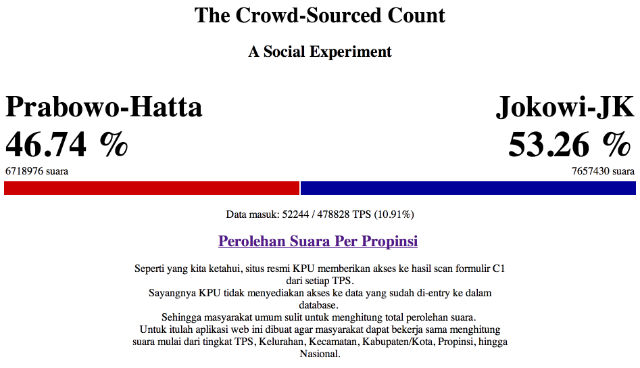SUMMARY
This is AI generated summarization, which may have errors. For context, always refer to the full article.
 JAKARTA, Indonesia – An Indonesian IT professional has embarked on a social experiment to see if the counting process of one of the world’s largest democratic elections can be crowdsourced.
JAKARTA, Indonesia – An Indonesian IT professional has embarked on a social experiment to see if the counting process of one of the world’s largest democratic elections can be crowdsourced.
Amid conflicting quick count results and reports of vote count fraud following the country’s July 9 presidential election, 37-year-old Reza Lesmana, who works in the telecommunications industry, created a website – Kawal Suara (guarding the vote) – that allows the public to help tally their own votes.
It is the latest example of private citizens’ efforts to monitor and guard the results of the tight presidential race between Jakarta Governor Joko “Jokowi” Widodo and former general Prabowo Subianto. Other efforts include MataMassa, a website developed by iLab and the Jakarta branch of the Alliance of Independent Journalists (AJI) to allow the public to submit allegations of electoral fraud, and this Tumbler account, which compiles images of problematic C1 forms.
“It’s a bit out of curiosity,” Reza told Rappler on why he started the site. “As you know the quick counts show a very narrow margin, and the KPU [General Election Commission] only releases the C1 image, which makes it very difficult for people to tally votes. So I figured we can try do something.”
Launched only on Saturday, July 12, and promoted through social media, Kawal Suara has now encoded more than 50,000 C1 forms – the tabulation sheet used at almost 480,000 polling centers throughout the country – or about 11% of the total.
“I’m quite surprised with the participation,” Reza said. “It was a bit slow on Saturday but then people started sharing it a lot on Sunday.”
The site links to the scanned image of the C1 forms uploaded on the KPU website, and then provides a form for anyone to encode the data. When a user clicks on “data entry” on the site’s homepage, he or she is given a random C1 form to encode.
While the site isn’t fool-proof, multiple users can encode the same C1 form and the site will acknowledge the most frequent data entered. Users can also double check the data entered by other users for each C1 form.
“I understand that this is a bit cumbersome, as other people have also mentioned. So I’m currently trying to come up with a way to conduct verification more easily. Perhaps something like showing a random C1 that has been filled in and simply asking the reviewer whether the data is correct or not,” Reza said.
The site also allows users to tag problematic C1 forms, such as those whose numbers don’t add up. “There’s quite a lot of those actually,” Reza said.
The goal, he said, is to simply make it easy for Indonesians to monitor the counting.
“This crowdsourced counting won’t be needed at all had KPU provided access to both the scanned forms and the vote data already entered into their database. That would make it easy for everyone, and lessen the chance for fraud.” – Rappler.com
Add a comment
How does this make you feel?
There are no comments yet. Add your comment to start the conversation.